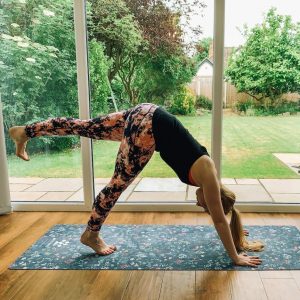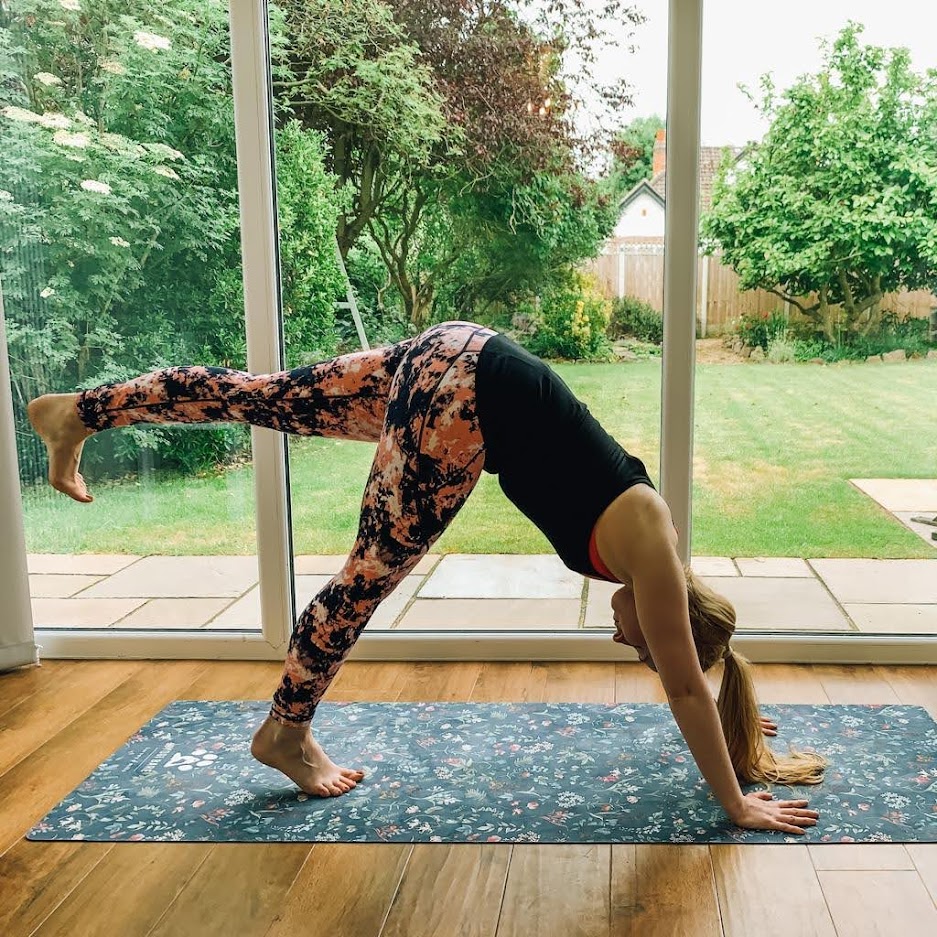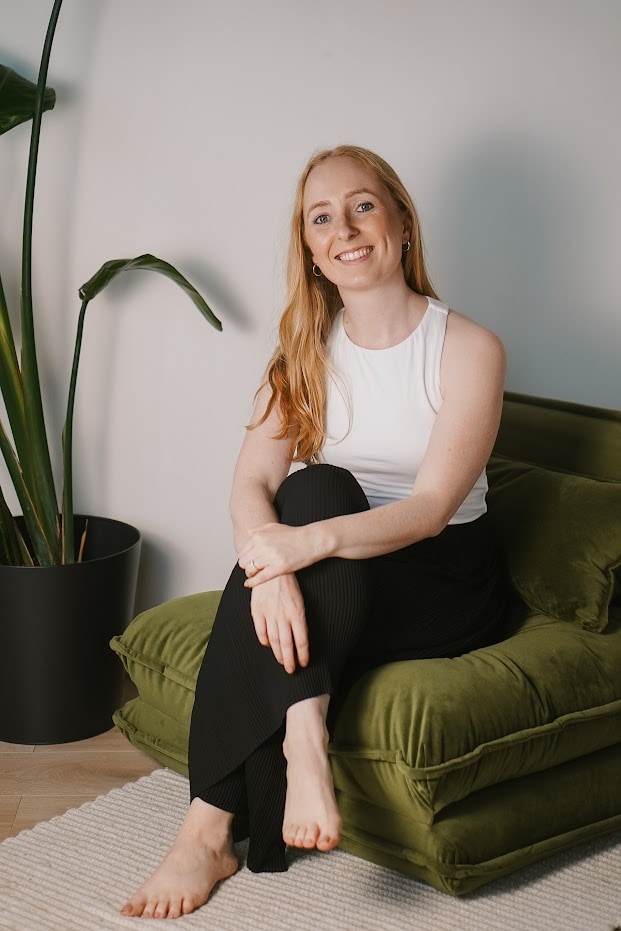How to keep your shoulders healthy when practicing yoga

The shoulders are the most mobile joint in the body, and in yoga we put a lot of demand on them! It’s important to keep the shoulders healthy in terms of both strength and mobility so we can keep practicing yoga for a long time. Here’s how…
What are the shoulders and how do we strengthen them?
This might sound like a ridiculous question, but when you think about the shoulders you might immediately think about the top of the shoulders. In fact, 3 bones come together to form the shoulder:
- Shoulder blade (back of the body)
- Humeral head (top of the arm bone)
- Clavicle + acromion (front of the body)
The shoulder is known as a ‘ball and socket’ joint – the humeral head forms the ‘ball’, which sits on the glenoid fossa which is the ‘socket’.
The hips are also ball-and-socket joints, but the hip socket is much deeper than the glenoid fossa.
You can think about the glenoid fossa as a golf tee – a very small surface for the humeral head to sit on. This smaller surface area means the arm can move in more ways, and is more mobile, and so the stability of the joint comes from the scapula in the back and the rotator cuff muscles in front.
Plus, the serratus muscle (one of my personal favourite muscles!) supports the shoulder blades and interdigitates with the obliques, which are the abdominal muscles used to rotate the torso. So, the shoulders have a direct connection in with our core too.
When our shoulders are strong, this gives us better stability through the core in weight-bearing positions.
As a result, every time we weight bear through the hands or forearms, the shoulder and the core are put under load too!
Since we put so much demand on the shoulders in yoga, there are a few crucial ways we can make sure the joint stays healthy. Here are my top 3 ways…
1. Keep your humerus centrated when you lower down from plank to chaturanga – avoid dipping your shoulders!
In yoga we do chaturangas a LOT so it’s really important that we train our shoulders to move in a healthy way.
When you come into your plank, aim to stack your shoulders directly above your wrists.
You might hear teachers say ‘shift forward’ in your plank. This is only necessary if your shoulders are behind your wrist in your plank to begin with. For most of us, the hands are in front of the feet in forward fold before coming into plank, so a shift forward is not only unnecessary but puts unnecessary strain on the shoulders!
We want to avoid pushing the shoulders forward of the wrist. When you do that in plank, as you lower into chaturanga, you will find that the humeral head – which is the top of your arm bone – is likely to sink down, pointing toward the floor.
This sinking action puts pressure on the rotator cuff and strains some of the muscles, ligaments and tissue structures in the shoulder.
Also, pay attention to your shoulder blades, also called your scapula. They should sit in a neutral position in plank to begin with – avoid protracting the shoulder blade, whereby your upper back rounds and the shoulders move away from the spine.
From a neutral position of the scapula, lower to the floor whilst keeping your elbows hugged in. You will feel your scapula pull together a little more at the lower end of the movement.
Top tip to help keep your shoulders centrated when lowering:
Centration means that the top of the arm bone, the humeral head, sits in the middle of the glenoid fossa, which is the ‘socket’ of this ball-and-socket joint. We want to make sure the humeral head stays in place as you lower, and one trick is to dial your hands outward. So, without moving your hands, imagine they are turning away from one another, like you are opening 2 jars of jam in opposite directions. This helps to ‘lock’ your arms in place.
2. Reach your arms forward and up, instead of out to the side, at the start of Sun Sals and Sequences
The shoulder can move in a variety of different ways and is inherently a very mobile joint. However, when the arm moves out to the side and upward, the humeral head has to clear the acromion process, which is a piece of bone that usually sits on top of the humeral head when the arms are hanging loose. You can see it in the picture below.
When you raise your arms out to the sides repeatedly, as we do in yoga – think about all the Sun Salutations we do! – over time this can create inflammation in either the tendons or bursa that sit between the acromion and the humeral head. This inflammation can feel sore or painful.
Instead, reach your arms forward and then upward. You can practice this movement:
- Bring your arms out in front of you at 90 degrees
- Reach your arms further by protracting your shoulder blades. Protracting means moving them away from the spine, so your arms move a little further in front of you.
- Then, lift your arms up overhead.
- Once your arms are up overhead, lift your rib cage up and away from the pelvis to create even more expansiveness!
The action of protraction helps to train the body for more optimal movement.
3. Practice postures that stabilise the shoulder by weight bearing through the wrists or forearms
One of the best ways to stabilise the shoulder is by doing postures that help with strength. The stability of the shoulder comes primarily from the shoulder blades on the back of the body and the rotator cuff at the front of the shoulder. When we put body weight through the hands or forearms, this creates a demand on the shoulders to stabilise. Over time, the joint will become more stabile as the muscles supporting the shoulder strengthen.
My favourite postures for this are:
- Downward dog
- Dolphin
- Plank and Forearm Plank
- Modified side plank & Side Plank
Notice if your shoulder rolls inward when doing these weight-bearing postures, especially in single-arm positions like modified side plank.
If you notice your humeral head rolling inward toward the centre of the body, focus on holding your shoulder blade in place from behind, which will pull it back.
If you would like some additional support, use your hand to cup the front of the shoulder. This will act in a similar way to your rotator cuff muscles and help hold the shoulder in place.
But don't forget about the rest of your body...
Lastly, remember the shoulder doesn’t operate in isolation.
As I mentioned at the start, the shoulder blades connect in via the serratus to the core. So, your shoulders impact your whole torso and vice versa.
Plus, if you are starting out with a postural imbalance such as protracted scapulaes or a tilted pelvis, the connective tissue in the back fascial line can pull on the shoulder blades in a way that creates an imbalance.
We always need to address the whole body, not just a single area, when trying to create more balance in the body.
Starting with these 3 tips will go a long way to ensuring your shoulders stay healthy when you practice yoga.




